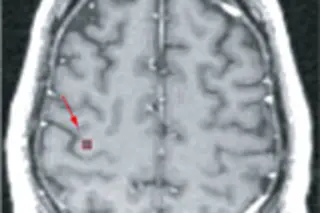The BrainGate implant's array of 100 hair-thin electrodes delves the cortex and eavesdrops on neurons that normally control hand and arm movement.
11. Neural Implant Empowers Paralyzed Man
Neuroscientist John Donoghue of Brown University has brought us a big step closer to the day when people can interact with computers directly through the power of thought. In July he and his team published a paper in Nature outlining remarkable progress in picking up brain signals with implanted electrodes and using those signals to control a range of devices.
The experiments were conducted on a 25-year-old Massachusetts man paralyzed from the neck down. In 2004, surgeons placed a tiny 100-electrode array in his primary motor cortex, the brain region that controls voluntary movement, to collect electrical impulses from nerve cells and send them to a series of signal processors. Donoghue and his colleagues then supervised as the computer translated the man's ...















